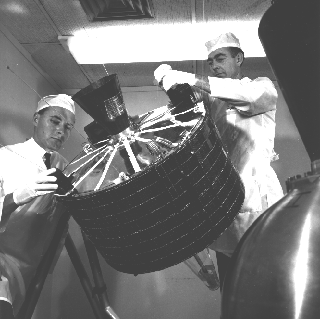
SHORT HISTORY

1955 John R. Pierce Article: "Orbital Radio Relays"
1956 First Trans-Atlantic Telephone Cable: TAT-11957 Sputnik: Russia launches the first earth satellite.
1960 1st Successful DELTA Launch Vehicle
1960 AT&T applies to FCC for experimental satellite communications license
1961 Formal start of TELSTAR, RELAY, and SYNCOM Programs
1962 TELSTAR and RELAY launched
1962 Communications Satellite Act (U.S.)1963 SYNCOM launched
1964 INTELSAT formed
1965 COMSAT's EARLY BIRD: 1st commercial communications satellite
1969 INTELSAT-III series provides global coverage
1972 ANIK: 1st Domestic Communications Satellite (Canada)
1974 WESTAR: 1st U.S. Domestic Communications Satellite
1975 INTELSAT-IVA: 1st use of dual-polarization
1975 RCA SATCOM: 1st operational body-stabilized comm. satellite
1976 MARISAT: 1st mobile communications satellite
1976 PALAPA: 3rd country (Indonesia) to launch domestic comm. satellite
1979 INMARSAT formed.
1988 TAT-8: 1st Fiber-Optic Trans-Atlantic telephone cable
- By the end of World War II, the world had had a taste of "global communications." Edward R. Murrow's radio broadcasts from London had electrified American listeners. We had, of course, been able to do transatlantic telephone calls and telegraph via underwater cables for almost 50 years. At exactly this time, however, a new phenomenon was born. The first television programs were being broadcast, but the greater amount of information required to transmit television pictures required that they operate at much higher frequencies than radio stations. For example, the very first commercial radio station (KDKA in Pittsburgh) operated ( and still does) at 1020 on the dial. This number stood for 1020 KiloHertz - the frequency at which the station transmitted. Frequency is simply the number of times that an electrical signal "wiggles" in 1 second. Frequency is measured in Hertz. One Hertz means that the signal wiggles 1 time/second. A frequency of 1020 kiloHertz means that the electrical signal from that station wiggles 1,020,000 times in one second.
- In fall of 1945 an RAF electronics officer and member of the British Interplanetary Society, Arthur C. Clarke, wrote a short article in Wireless World that described the use of manned satellites in 24-hour orbits high above the world's land masses to distribute television programs. His article apparently had little lasting effect in spite of Clarke's repeating the story in his 1951/52 The Exploration of Space. Perhaps the first person to carefully evaluate the various technical options in satellite communications and evaluate the financial prospects was John R. Pierce of AT&T's Bell Telephone Laboratories who, in a 1954 speech and 1955 article, elaborated the utility of a communications "mirror" in space, a medium-orbit "repeater" and a 24-hour-orbit "repeater." In comparing the communications capacity of a satellite, which he estimated at 1,000 simultaneous telephone calls, and the communications capacity of the first trans-atlantic telephone cable (TAT-1), which could carry 36 simultaneous telephone calls at a cost of 30-50 million dollars, Pierce wondered if a satellite would be worth a billion dollars.
- After the 1957 launch of Sputnik I, many considered the benefits, profits, and prestige associated with satellite communications. Because of Congressional fears of "duplication," NASA confined itself to experiments with "mirrors" or "passive" communications satellites (ECHO), while the Department of Defense was responsible for "repeater" or "active" satellites which amplify the received signal at the satellite--providing much higher quality communications. In 1960 AT&T filed with the Federal Communications Commission (FCC) for permission to launch an experimental communications satellite with a view to rapidly implementing an operational system.

'Sputnik' 1 in 1957
- By 1964, two TELSTARs, two RELAYs, and two SYNCOMs had operated successfully in space. This timing was fortunate because the Communications Satellite Corporation (COMSAT), formed as a result of the Communications Satellite Act of 1962, was in the process of contracting for their first satellite.
- By the end of 1965, EARLY BIRD had provided 150 telephone "half- circuits" and 80 hours of television service. The INTELSAT II series was a slightly more capable and longer-lived version of EARLY BIRD. Much of the early use of the COMSAT/INTELSAT system was to provide circuits for the NASA Communications Network (NASCOM). The INTELSAT III series was the first to provide Indian Ocean coverage to complete the global network. This coverage was completed just days before one half billion people watched APOLLO 11 land on the moon on July 20, 1969.
- The first major geosynchronous satellite project was the Defense Department's ADVENT communications satellite. It was three-axis stabilized rather than spinning. It had an antenna that directed its radio energy at the earth. It was rather sophisticated and heavy. At 500-1000 pounds it could only be launched by the ATLAS- CENTAUR launch vehicle. ADVENT never flew, primarily because the CENTAUR stage was not fully reliable until 1968, but also because of problems with the satellite. When the program was canceled in 1962 it was seen as the death knell for geosynchronous satellites, three-axis stabilization, the ATLAS-CENTAUR, and complex communications satellites generally. Geosynchronous satellites became a reality in 1963, and became the only choice in 1965. The other ADVENT characteristics also became commonplace in the years to follow.